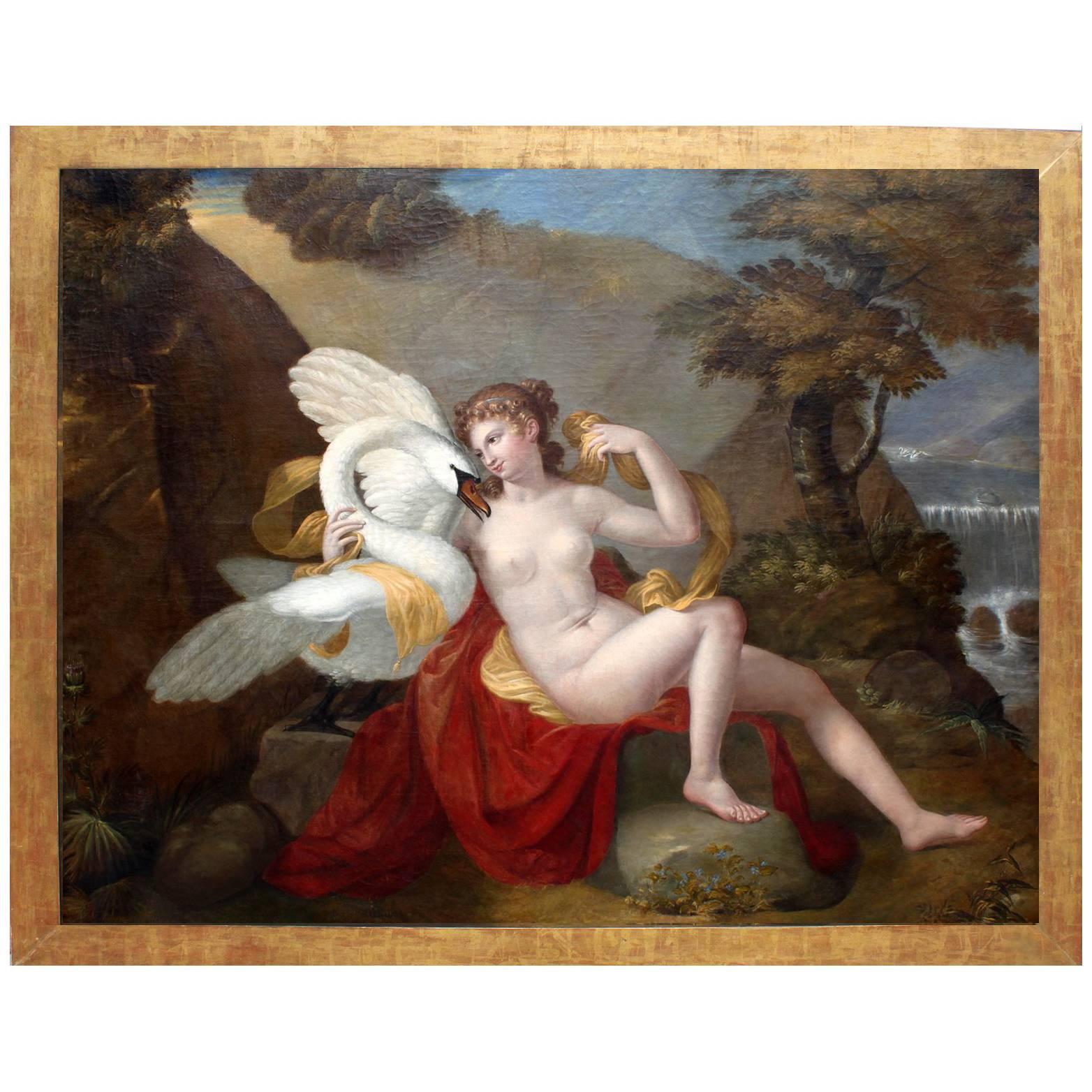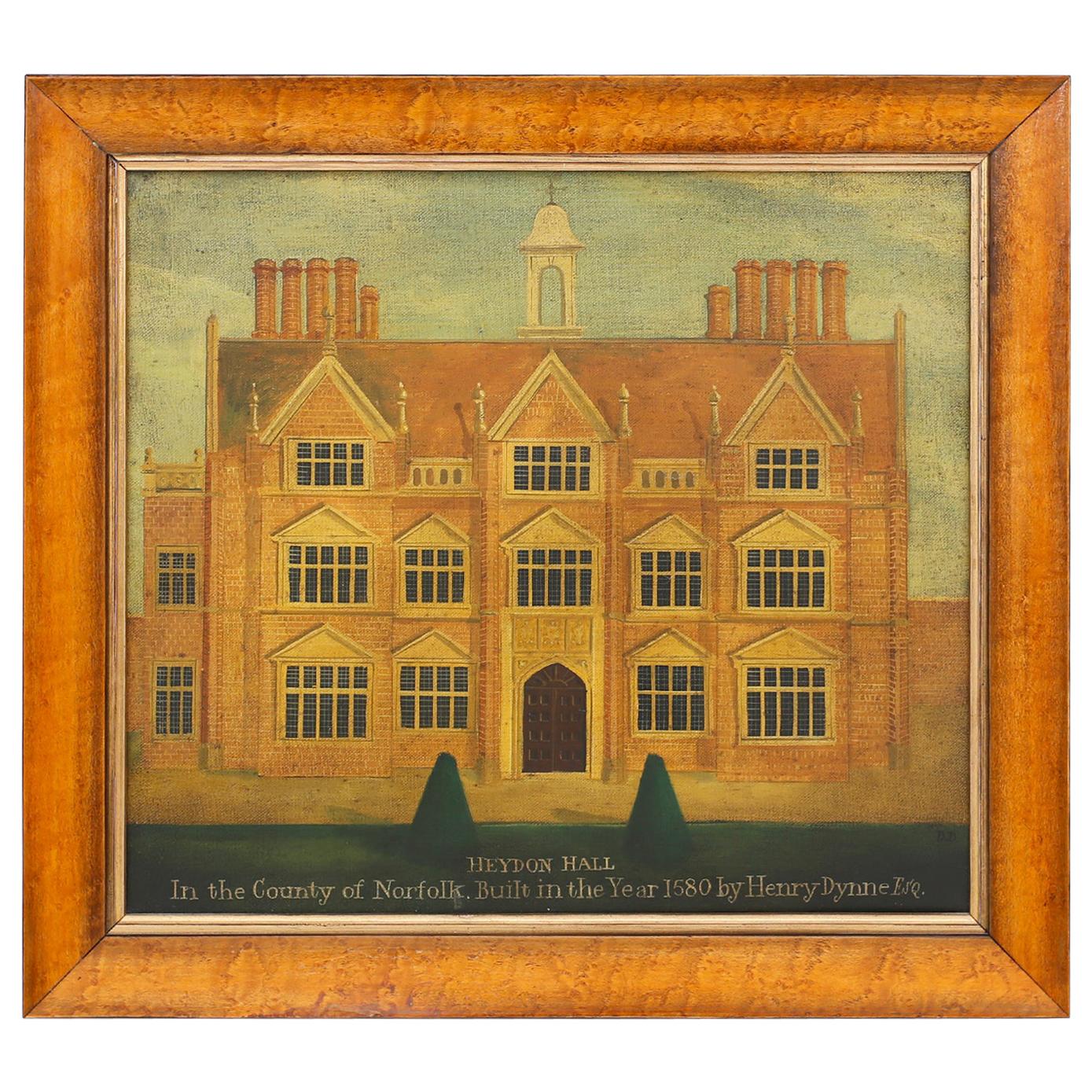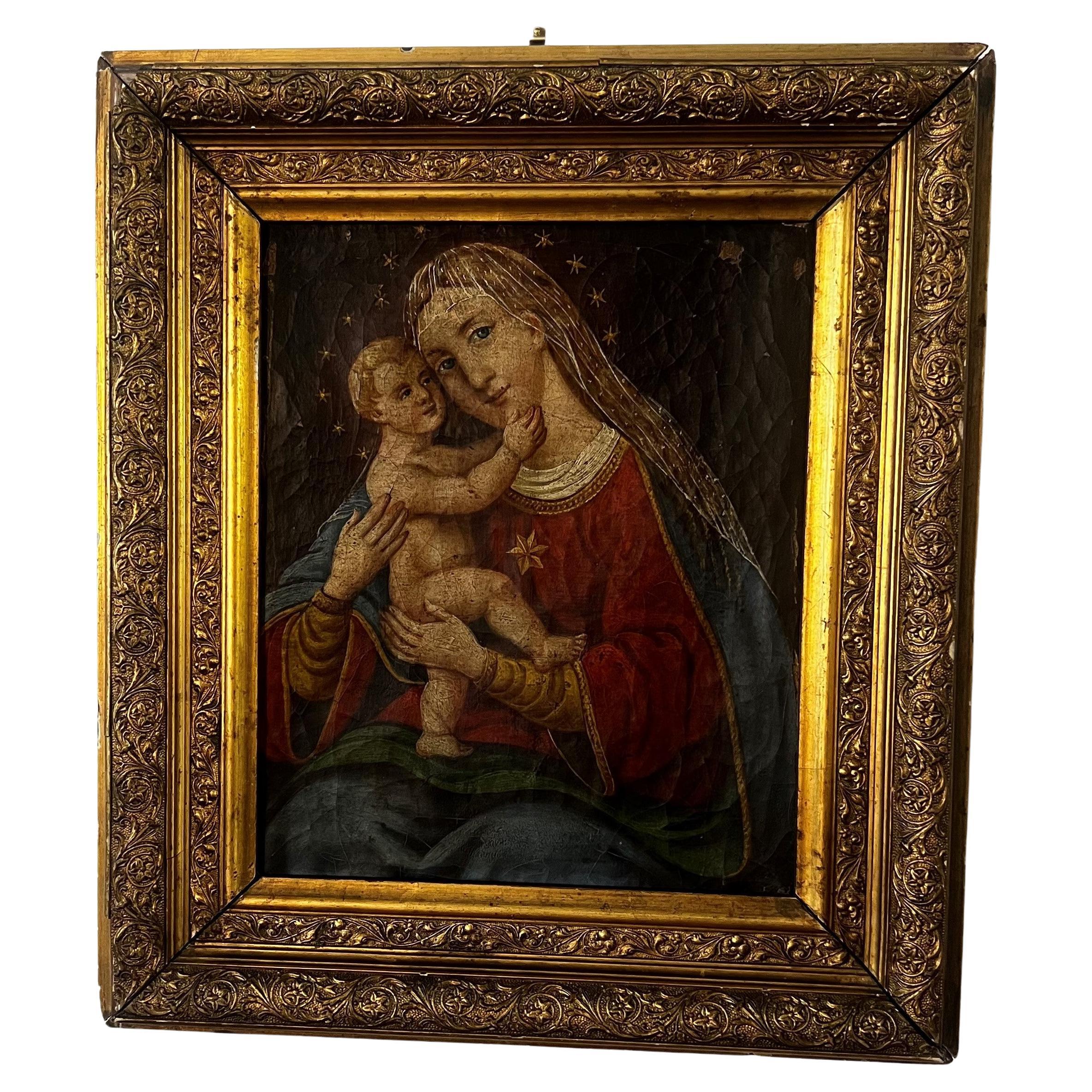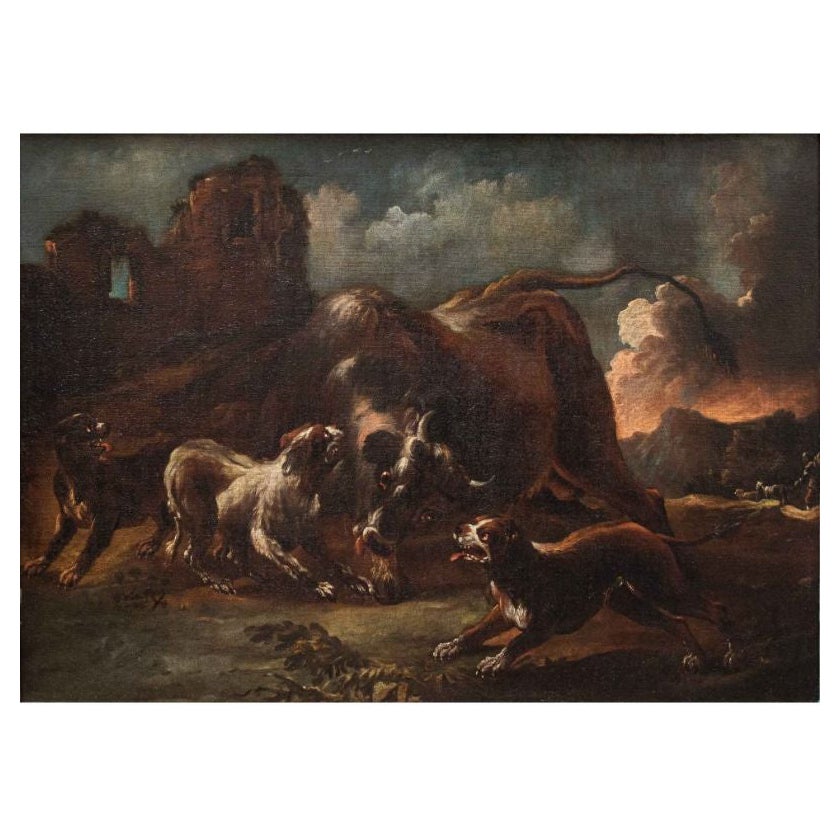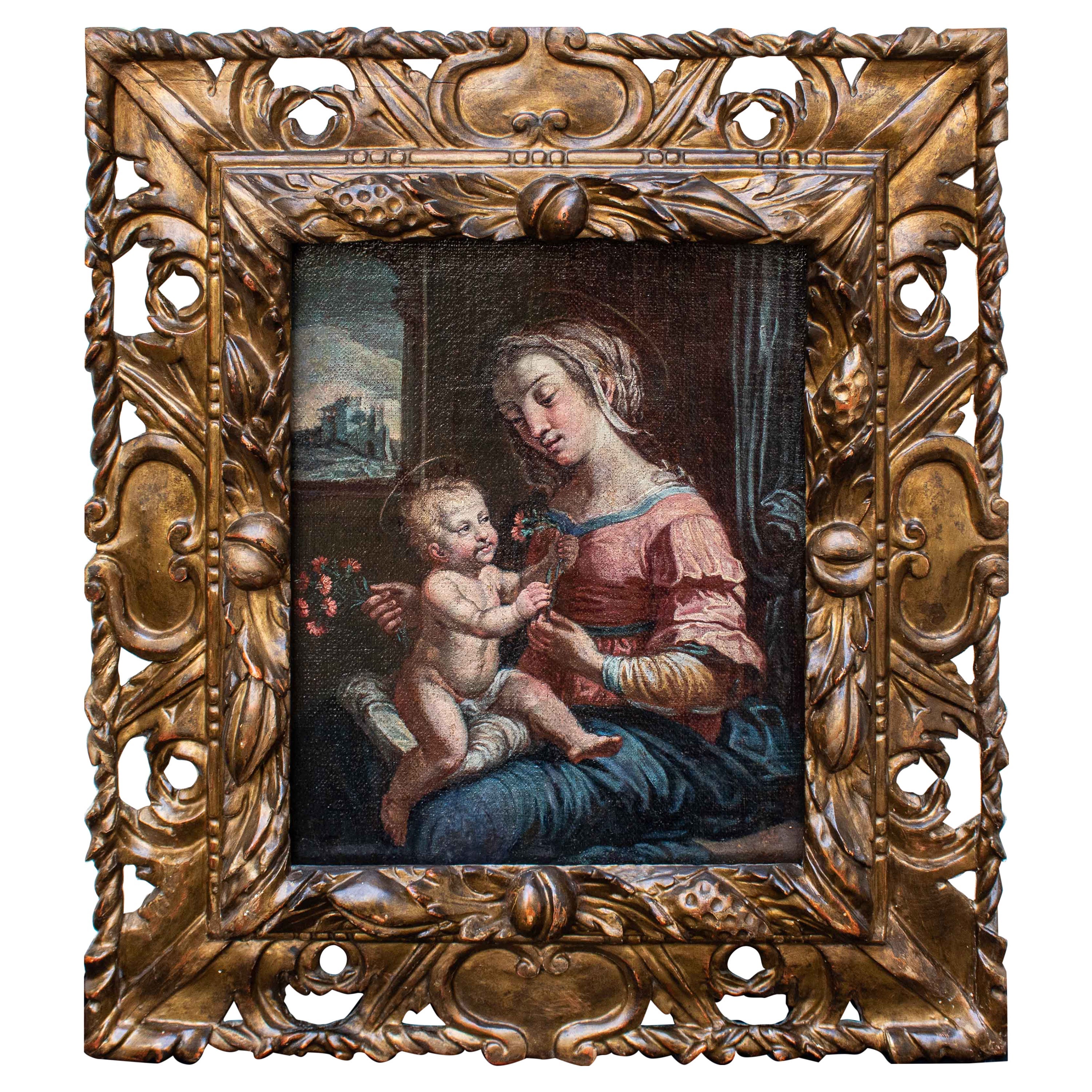Items Similar to Mannerist painter, Leda and the Swan, Oil on canvas, 16th century
Want more images or videos?
Request additional images or videos from the seller
1 of 11
Mannerist painter, Leda and the Swan, Oil on canvas, 16th century
About the Item
Mannerist painter, 16th century
Leda and the Swan
Oil on canvas, 87.5 x 142 cm
Initial 'P' in center of pillow embroidery
Leda, queen of Sparta and bride of Tindarus, is lying on a sheet with her torso raised by a white pillow. To his figure, which occupies the entire space of the canvas, that of Zeus in the disguise of a swan is suavely lined up. Following this union, according to the myth, Leda laid an egg from which Helen, Pollux, Castor and Clytemnestra were born. The story was supposed to take place along the Eurota River, but the backdrop in the present painting is a detailed dante view of a mountain range surrounding a lake, and some buildings. Prominent among these are an aqueduct and the Cestia Pyramid-a landscape piece of great quality, in essence, especially in the chromatic rendering of the surrounding vegetation and the softly outlined mountains, so much so that it suggests the artist studied the works of the master Leonardo.
The voluminousness of the female figure harks back to Mannerist stylistic features, and it is therefore possible to circumscribe its chronological realization range to the mid-sixteenth century. For the origins of the iconography of the reclining Leda, in ancient times preferred in the standing variant, it is necessary to dwell on an engraving by Albrecht Dürer (1471-1528), depicting the woman in the company, instead of the swan, of a sea creature. Caesar Reverdinus (second half of the 16th century) resumed this work in the immediate future, this time flanking Queen Zeus under changed forms. It is Michelangelo's lost version, however, that has inspired the greatest number of replicas: painted on commission by Alfonso I d'Este, duke of Ferrara, the canvas imposed itself as an open challenge to fellow Titian, who had just delivered three paintings to the duke. Michelangelo completed the work, according to biographer Condivi of massive size, by 1530 or the following year; it would seem that, in response, Titian immortalized the famous Danae now in the collection of the Capodimonte Museum and Real Bosco, which Michelangelo saw when in Rome but criticized, in 1545. Following an argument with the duke's representative, the Tuscan artist donated canvas and preparatory cartoon to his pupil Antonio Mini, who took both to France to sell them to Francis I. Although tradition would have it that it was the superintendent of Fontainebleau Des Noyers who burned the original painting for indecency, records of its disappearance are still lacking: we do know, however, that Cornelis Bos made an engraved copy and that Michelangelo himself made a study for Leda's face in red plaster, which is now preserved at Casa Buonarroti in Florence. The oldest replica of the master's canvas to date turns out to be the painting on display at the National Gallery in London, although the Dioscuri mentioned by Cornelis instead do not appear there. Long attributed to Rosso Fiorentino because of the testimony of Cassiano del Pozzo, who saw a similar one within the Fontainebleau picture gallery in 1625 and also because of the cartoon that Vasari records as being present in the artist's studio at the time of his death in 1540 (London, Royal Academy of Arts), the canvas has now been more prudently traced to an anonymous hand.
The variant of the reclining Leda, also recurring in a sculpture by Bartolomeo Ammanati (Florence, Museo Nazionale del Bargello), was juxtaposed through Leonardo da Vinci with that of the queen near a reedbed kneeling (Study for Leda, Rotterdam, Boymans-van Beuningen Museum and Chatsworth House, Derbyshire), soon taken up by the large host of his pupils including Cesare da Sesto (Rome, Galleria Borghese) and Francesco Melzi (Florence, Uffizi Galleries). Later Raphael replicated a Leonardesque study by proposing a standing Leda (Windsor, Royal Collection).
The item is in good condition
- Dimensions:Height: 34.26 in (87 cm)Width: 55.91 in (142 cm)Depth: 1.19 in (3 cm)
- Materials and Techniques:Canvas,Oiled
- Period:
- Date of Manufacture:unknown
- Condition:Additions or alterations made to the original.
- Seller Location:Milan, IT
- Reference Number:1stDibs: LU5918239031112

About the Seller
5.0
Vetted Seller
These experienced sellers undergo a comprehensive evaluation by our team of in-house experts.
Established in 2000
1stDibs seller since 2021
25 sales on 1stDibs
Typical response time: 10 hours
- ShippingRetrieving quote...Ships From: Milan, Italy
- Return PolicyA return for this item may be initiated within 14 days of delivery.
More From This SellerView All
- 16th Century Animals Painting Oil on Canvas by CrivellinoLocated in Milan, ITGiovanni Crivelli known as Crivellino (Milan,? - Parma, 1760) Fight between dogs and bison Oil on canvas, 84 x 111 cm With frame 112 x 139 cm Thanks to the comparison with h...Category
Antique 16th Century Italian Paintings
MaterialsCanvas
- 16th Century Madonna of the Carnations Painting Oil on Canvas from RaffaelloBy Raphael (Raffaello Sanzio da Urbino)Located in Milan, IT16th century, by Raffaello Sanzio (Urbino, 1483 - Rome, 1520) Madonna of the Carnations Measures: Oil on canvas 38 x 30 - with frame 59 x 52.5 cm The Madonna dei Garofani made b...Category
Antique 16th Century Italian Paintings
MaterialsCanvas
- Venetian school, Tobias and Sara in Nineveh, oil on canvas, 16th centuryLocated in Milan, ITVenetian School, second half of the 16th century Tobiah and Sarah led to Nineveh by the archangel Azariah Oil on canvas, 48 x 56 cm - Framed, 58 x 72 cm The present canvas, made w...Category
Antique 16th Century Paintings
MaterialsCanvas
- 16th Century Adoration of The Shepherds Painting Oil on CopperLocated in Milan, ITAttr. to Girolamo Siciolante known as da Sermoneta (Sermoneta, 1521 - Rome, 1575) Adoration of the Shepherds Oil on copper, 39 x 29.5 cm Frame 47 x 39 cm The refined taste, the refined poses, the definition of the anatomies, the vibrant light, allow us to identify for this painting the hand of a Mannerist painter active during the sixteenth century. In particular, the composition and stylistic research allow us to attribute the panel to Girolamo Siciolante, known as da Sermoneta (1521 - 1575). His first training took place under the guidance of Leonardo Grazia known as da Pistoia (1502 - 1548). Later he settled in Rome where he was able to see the painting of Raphael and Michelangelo from life and where he was first a pupil and then a collaborator of Perin del Vaga...Category
Antique 16th Century Italian Paintings
MaterialsCopper
- 16th-17th Century Gentleman’s Portrait Oil on Canvas by Francesco ZuccoLocated in Milan, ITFrancesco Zucco (circa 1575-1627) Gentleman’s portrait Measures: Oil on canvas, cm 120 x 140 The painting analyzed here belongs to the pictorial production of Francesco Zucc...Category
Antique Early 17th Century Paintings
MaterialsCanvas
- 16th Century Adoration of the Shepherds Painting Oil on Copper by CarnevaleBy Carnevale StudioLocated in Milan, ITDomenico Carnevale (Sassuolo, 1524 - Modena, 1579) Adoration of the Shepherds Oil on copper, 42 x 28 cm Frame 54 x 36 cm Expert opinion of Prof. Emilio Negro The painting represents the Adoration of the Shepherds, the Child in the center, next to the Madonna kneeling in prayer and an angel behind her; towards him in the foreground a woman with a child in her arms, a shepherd with a sheep on the right, a bagpiper on the left and various other male and female characters turn to him. The architectures of the background, between which a glimpse of the landscape can be glimpsed, are hidden in the upper part by the clouds, where a "celestial glory" encamps with three flying angels. The painting shows mannerist characters that can be traced back to the second half of the sixteenth century, and can be traced back to an author from the Modena area, with stylistic references to the Bolognese Samacchini (1532 - 1577) and Passerotti (1529 - 1592). More precisely, it can be attributed to Domenico Carnevale (1524-1579), one of the most important masters of the sixteenth century active in the local area. The Carnival was formed in Emilia, his homeland, where he worked for many years. However, his works also show a clear Roman influence, dictated by a long experience in the city, during which he also dedicated himself to the restoration of the Sistine Chapel. Trained in the late-mannerist environment of Modena, he is also linked to the Parmesan Corrorese and Ferrarese Dossesque tradition; Carnival also always maintains a slight archaic sentiment in his work, The main stylistic reference must be identified in a work similar in subject and iconographic setting, coming from the church of the Pio Istituto Orfanelle di San Geminiano di Modena, currently part of the Art Collection of the Province, attributed to the same influence as the Carnival. Another interesting comparison should be identified with A Presentation of Jesus in the Temple...Category
Antique 16th Century Italian Paintings
MaterialsCopper
You May Also Like
- French 19th Century Old Master School Oil on Canvas Titled "Leda and The Swan"Located in Los Angeles, CAA fine and large French 19th century old master school oil on canvas titled "Leda and The Swan" within a giltwood frame. Leda and the swan is a motif from Greek mythology, in which Z...Category
Antique 19th Century French Renaissance Revival Paintings
MaterialsGiltwood, Canvas
- Virgin of the Immaculate Conception, 16th Century, Oil on CanvasLocated in North Miami, FL16th Century Spanish Colonial Oil on canvas painting of the Virgin of the Immaculate Conception. In this representation of the Virgin Mary being f...Category
Antique 16th Century Spanish Spanish Colonial Paintings
MaterialsCanvas, Wood, Paint
- Oil Painting on Canvas of a 16th Century BuildingLocated in Palm Beach, FLArchitectural oil painting on canvas of Heydon Hall executed in a rustic naive style with contrived aging and presented in a maple frame. Signed Dan Dunton.Category
20th Century English Folk Art Paintings
MaterialsPaint
- Venetian 16th Century Madonna and Child Jesus Oil on CanvasLocated in Doha, QAOver the centuries, in period known as Renaissance, more than several painters all over Europe were fascinated by the theme based upon similar subject with Mother and the Child as main figures. This stunning Madonna with Child oil on canvas painting is approximately from 16th century and could belong to a follower or a circle of Giovanni Bellini...Category
Antique 16th Century Italian Renaissance Paintings
MaterialsCanvas
- 16th century oil on wood panel Italian noblemanLocated in Braintree, GB16th Century oil on wood panel painting featuring Italian Nobleman. Note: No frame Dimensions: Height x width: 34 x 28.2 cm Depth: 0.8 cm...Category
Antique 16th Century Italian Paintings
MaterialsWood
- 16th Century Oil on Canvas Italian Religious Painting Madonna Child Saints, 1580Located in Vicoforte, PiedmontAntique painting of the Venetian school from the second half of the 16th century. Oil on canvas artwork depicting the Madonna and Child with Saints, of excellent pictorial quality. W...Category
Antique 18th Century and Earlier Italian Paintings
MaterialsCanvas
